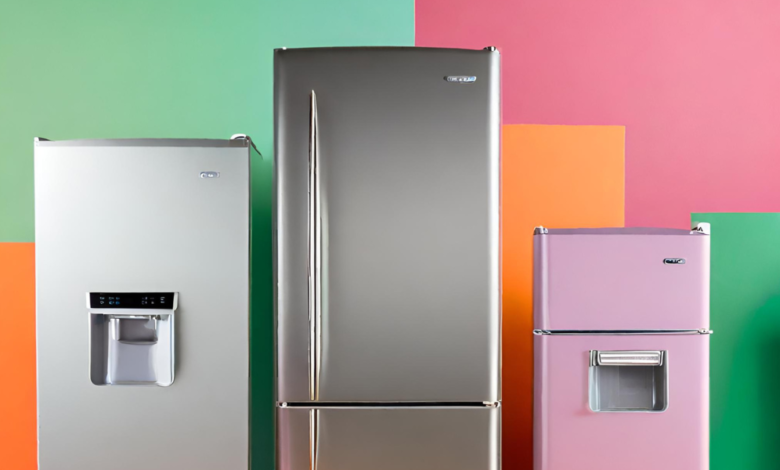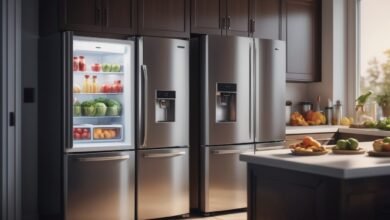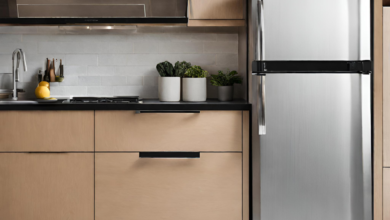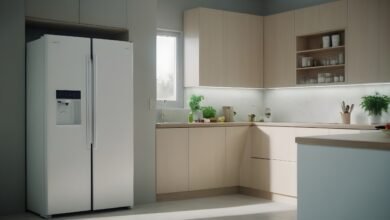Matching Your Kitchen Design with the Appropriate Fridge Dimensions

Creating a cohesive and visually appealing kitchen involves more than just selecting stylish cabinetry and countertops; it also requires careful consideration of the dimensions of your appliances. Among these, the refrigerator stands out as a focal point, both in terms of functionality and aesthetics. In this comprehensive guide, we will explore the art of matching your kitchen design with the appropriate fridge dimensions. From understanding different kitchen styles to selecting the right refrigerator type and size, we’ll delve into the details that contribute to a harmonious and well-balanced kitchen.
The Role of Refrigerators in Kitchen Design
Refrigerators are not merely utilitarian appliances; they contribute significantly to the overall design language of your kitchen. The right refrigerator dimensions can enhance the flow of the space, complement the style of cabinetry, and create a seamless visual appeal. Understanding how to match your kitchen design with the appropriate fridge dimensions involves a nuanced approach that considers both form and function.
Understanding Different Kitchen Styles
Before delving into the specifics of refrigerator dimensions, it’s crucial to identify the style of your kitchen. Different design aesthetics demand different approaches to appliance integration. Let’s explore a few popular kitchen styles and how refrigerator dimensions can align with each.
1. Modern Kitchens
Modern kitchens often feature sleek, clean lines and minimalistic designs. For these kitchens, consider a refrigerator with a stainless steel finish and a streamlined, handle-less door design. Opt for a counter-depth model to maintain a seamless look and prevent the refrigerator from protruding into the space.
2. Traditional Kitchens
Traditional kitchens, with their classic and timeless appeal, are characterized by intricate details, raised panel cabinetry, and often a warm color palette. A refrigerator with a built-in or panel-ready design can seamlessly blend into the cabinetry, maintaining the traditional aesthetic.
3. Transitional Kitchens
Transitional kitchens strike a balance between modern and traditional elements. In these kitchens, you have the flexibility to choose a refrigerator that complements both styles. Consider a French door or side-by-side refrigerator with stainless steel finishes for a versatile and timeless look.
4. Industrial Kitchens
For industrial-style kitchens with exposed brick, metal accents, and open shelving, a stainless steel refrigerator with a commercial-style appearance can be a perfect fit. Opt for a larger model with robust handles to evoke an industrial vibe.
Assessing Fridge Dimensions for Different Layouts
1. Galley Kitchens
Galley kitchens are characterized by parallel counters and a narrow space. In such kitchens, it’s crucial to maximize functionality without overwhelming the space. Opt for a slim, counter-depth refrigerator to maintain a streamlined look. Consider a top-freezer model for efficient use of vertical space.
2. Open-Concept Kitchens
In open-concept kitchens where the refrigerator is visible from various angles, aesthetics play a significant role. Choose a refrigerator with a stylish exterior and a configuration that complements the overall design. French door or side-by-side models can add an elegant touch.
3. U-Shaped and L-Shaped Kitchens
These layouts offer more flexibility in terms of refrigerator placement. Consider a standard-depth refrigerator that seamlessly integrates into the cabinetry. Pay attention to the door swing to ensure it doesn’t obstruct the natural flow within the kitchen.
4. Kitchen Islands
For kitchens with islands, refrigerator placement becomes even more critical. In such cases, a counter-depth or built-in refrigerator can be an excellent choice, allowing for easy access to both the refrigerator and the island.
Selecting the Right Refrigerator Type
Once you’ve identified your kitchen style and layout, it’s time to explore different types of refrigerators and their dimensions. The right refrigerator type can enhance both the functionality and visual appeal of your kitchen.
1. Top-Freezer Refrigerators
These classic models have the freezer compartment at the top and are known for their straightforward design. They are space-efficient and can be an excellent choice for smaller kitchens where vertical space is essential.
2. Bottom-Freezer Refrigerators
With the freezer at the bottom, these refrigerators offer easy access to fresh food at eye level. Their contemporary design makes them suitable for various kitchen styles, and they are available in both standard and counter-depth options.
3. Side-by-Side Refrigerators
Featuring vertical doors that split the refrigerator into fresh food and freezer compartments, side-by-side refrigerators are space-saving. They are well-suited for kitchens with narrow spaces and can complement modern or transitional designs.
4. French Door Refrigerators
Known for their elegant and sophisticated appearance, French door refrigerators have two doors for the fresh food compartment and a bottom freezer drawer. These models often come with advanced features and are suitable for spacious kitchens with a focus on aesthetics.
5. Counter-Depth Refrigerators
Designed to align with standard kitchen cabinets, counter-depth refrigerators provide a built-in look. While they may have slightly less storage capacity, they contribute to a seamless and cohesive appearance, especially in modern and minimalist kitchens.
Measuring and Matching
1. Width, Height, and Depth
Before making a final decision, measure the available space for your refrigerator meticulously. Consider the width, height, and depth, taking into account any obstructions or architectural features. Ensure that the chosen refrigerator dimensions align with the available space.
2. Cabinet Integration
If you aim for a built-in look, opt for a refrigerator with panel-ready options or a design that allows for easy integration with custom cabinetry. This creates a cohesive appearance, especially in kitchens with a traditional or modern aesthetic.
3. Handle Styles
Pay attention to handle styles. Some refrigerators come with integrated handles for a sleek look, while others feature prominent handles that can contribute to a more robust or industrial appearance. Choose handles that complement the overall style of your kitchen.
Color and Finish Coordination
Beyond dimensions, the color and finish of your refrigerator can significantly impact its integration into the kitchen design. Consider the following tips for color coordination:
1. Stainless Steel Finishes
Stainless steel finishes are versatile and can complement various kitchen styles. However, be mindful of fingerprints and smudges, especially if you have young children. Look for fingerprint-resistant stainless steel options for easier maintenance.
2. Panel-Ready Options
For a seamless and integrated look, consider panel-ready refrigerators that allow you to attach custom panels that match your cabinetry. This creates a cohesive appearance, particularly in traditional and modern kitchens.
3. Bold Colors
If you’re feeling adventurous, consider bold-colored refrigerators. This can add a pop of personality to the kitchen and serve as a focal point. Ensure that the color complements the overall color scheme of the space.
Lifestyle and Special Features
Consider your lifestyle and preferences when selecting a refrigerator. Modern appliances come with a range of features designed to enhance convenience and functionality.
1. Water and Ice Dispensers
Built-in water and ice dispensers are convenient but require a water connection. Consider whether these features align with your lifestyle and if the space they occupy in the refrigerator door is acceptable.
2. Smart Technology
Explore refrigerators with smart technology features such as touchscreens, Wi-Fi connectivity, and compatibility with smart home systems. While these features may not be essential, they can provide added convenience and control over your appliance.
3. Door-in-Door Design
Some models feature a door-in-door design, allowing you to access frequently used items without fully opening the refrigerator door. This can contribute to energy savings and maintain temperature levels.
Budget Considerations
While designing your dream kitchen is exciting, it’s essential to balance your aspirations with budget considerations. Fortunately, there are options available at various price points that offer a blend of style and functionality.
1. Establish a Budget Range
Determine a budget range for your refrigerator. This can guide your selection process and help you narrow down options that align with your financial constraints.
2. Prioritize Essential Features
Identify the features that are essential for your needs and prioritize them. While advanced features can be enticing, focusing on the functionalities that truly matter to you can help you make a more informed decision within your budget.
3. Consider Refurbished or Open-Box Options
Explore refurbished or open-box options from reputable retailers. These appliances are often significantly discounted and can provide excellent value while still offering reliable performance. Ensure that they come with a warranty and meet your quality standards.
Conclusion
Matching your kitchen design with the appropriate fridge dimensions involves a comprehensive understanding of your kitchen style, layout, and personal preferences. By carefully considering the aesthetics, dimensions, and features of different refrigerator types, you can create a kitchen space that seamlessly integrates functionality and visual appeal. Remember to measure meticulously, coordinate colors and finishes, prioritize energy efficiency, and stay within your budget to achieve a well-balanced and harmonious kitchen design that reflects your unique taste and lifestyle.






